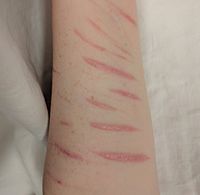
Photo from wikipedia
Introduction Often when individuals with body piercings, tattoos or body modifications are seen, strong reactions are elicited involving taboo subject matter, criminal predisposition, substance abuse and reckless behaviors. Despite such… Click to show full abstract
Introduction Often when individuals with body piercings, tattoos or body modifications are seen, strong reactions are elicited involving taboo subject matter, criminal predisposition, substance abuse and reckless behaviors. Despite such stereotypes, piercing and body modifications are growing in popularity and becoming more mainstream. Identification of the problem No formal education for health care providers exists on body piercings/body modifications. The knowledge gap is compounded by lack of medical research on the topic. EBP Question/Purpose: PICO question. Databases utilized How can patients with piercings and body modifications receive appropriate care from healthcare providers during their hospitalization? In an age where piercings and body modifications are commonplace, nurses need to know proper patient care. Preventing the piercing site from closing is a major concern of patients during their hospital stay. Furthermore, questions arise regarding the safety of surgical and radiological procedures in the presence of body piercing/modifications. A literature synthesis was conducted within CINAHL, PubMed, Uptodate and Embase using the following search terms, alone/in combinations: body modifications, body art, body piercing, tattoo, healthcare, and nursing. Methods/Evidence Sources were limited to English-language and human adult/adolescent participants. The combined search yielded 74 publications. After initial screening, 38 articles were examined. Twenty-three articles were excluded due to content unrelated to healthcare. The final sample of 15 publications formed the basis of the literature review. Significance of Findings/Outcomes The mechanisms for nurses to remove body jewelry are examined. Maintaining patency for both small and large piercing tracts using items such as plastic intravenous catheters (IVs) are discussed. Patient involvement in removing/replacing body jewelry is encouraged. Concerns are addressed regarding the potential complications that may occur when an individual with body modifications is exposed to diagnostic imaging including mild burns and discomfort. Scarification can reduce skin accessibility for catheter insertions and/or a surgical incision and may lead to additional surgery time. Subdermal implants are generally composed of silicone or Teflon but may be metal. Patient with implants may not be able to undergo MRI diagnostics and/or may need the implant surgically removed if within the surgical field. Implications for perianesthesia nurses and future research This presentation provides the best practice recommendation for perioperative health care providers regarding the care of patients with body piercing/modifications. Enhancing nursing knowledge of body piercing/modifications provides the patient with care that is appropriate and sensitive to the patient.
Journal Title: Journal of PeriAnesthesia Nursing
Year Published: 2021
Link to full text (if available)
Share on Social Media: Sign Up to like & get
recommendations!